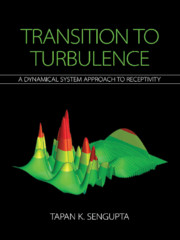Book contents
- Frontmatter
- Dedication
- Contents
- Preface
- 1 Receptivity, Instability, and Transition: A Perspective
- 2 Dynamical System Theory and Role of Equilibrium Flows
- 3 Fundamentals of Scientific Computing
- 4 Instability and Transition
- 5 Receptivity Analysis: Relation with Instability Experiments
- 6 Dynamical System Theory of Linear Receptivity
- 7 Nonlinear, Nonparallel Effects on Receptivity, Instability, and Transition
- 8 Three-Dimensional Routes of Transition to Turbulence
- 9 Receptivity to Free Stream Excitation: Theory, Computations, and Experiments
- 10 Nonlinear Receptivity Theories: Hopf Bifurcations and Proper Orthogonal Decomposition for Instability Studies
- 11 Mixed Convection Flow
- 12 Baroclinic Instability: Rayleigh–Taylor Instability
- 13 Coherent Structure Tracking in Transitional and Turbulent Flows
- 14 The Route of Transition to Turbulence: Solution of Global Nonlinear Navier–Stokes Equation
- References
13 - Coherent Structure Tracking in Transitional and Turbulent Flows
Published online by Cambridge University Press: 16 February 2021
- Frontmatter
- Dedication
- Contents
- Preface
- 1 Receptivity, Instability, and Transition: A Perspective
- 2 Dynamical System Theory and Role of Equilibrium Flows
- 3 Fundamentals of Scientific Computing
- 4 Instability and Transition
- 5 Receptivity Analysis: Relation with Instability Experiments
- 6 Dynamical System Theory of Linear Receptivity
- 7 Nonlinear, Nonparallel Effects on Receptivity, Instability, and Transition
- 8 Three-Dimensional Routes of Transition to Turbulence
- 9 Receptivity to Free Stream Excitation: Theory, Computations, and Experiments
- 10 Nonlinear Receptivity Theories: Hopf Bifurcations and Proper Orthogonal Decomposition for Instability Studies
- 11 Mixed Convection Flow
- 12 Baroclinic Instability: Rayleigh–Taylor Instability
- 13 Coherent Structure Tracking in Transitional and Turbulent Flows
- 14 The Route of Transition to Turbulence: Solution of Global Nonlinear Navier–Stokes Equation
- References
Summary
Introduction
In Chapter 9, two nonlinear theories have been described to predict the onset and growth of disturbance fields. For incompressible flows, these are derived from the Navier–Stokes equation without resorting to any assumptions, based on the disturbance mechanical energy (DME) and the disturbance enstrophy transport equation (DETE), and are given in Eqs. (9.7) to (9.11). In studying transitional and turbulent flows, one begins with the details of the receptivity of the equilibrium flow to imposed perturbations. These are ingested in the flow and evolve via various instability stages. The onset or the receptivity stage strongly depends on the way the equilibrium flow is excited. It has been clearly described in Chapters 5, 6, 8 and 9 that there are two prototypical routes of causing transition for the flow over the canonical semi-infinite flat plate [298]: (i) where the boundary layer is excited at the wall [32, 34, 134, 509], experimentally investigated in [236, 405, 565], and (ii) where the flow transition is triggered by free stream excitations, studied theoretically and experimentally in [225, 267, 431, 559]. The second route of excitation has been originally conceptualized by Taylor [510] in trying to quantify the effects of free stream turbulence. This has been endorsed by Monin and Yaglom [295] subsequently. In this chapter, the methods which trace disturbances from the onset to fully developed turbulent stages are discussed. Thus, it is essential that one understands the genesis and growth of disturbances in the first place. That there is multiplicity of point of views about the receptivity or onset stage itself, is well known.
Even for the canonical flow over a semi-infinite flat plate, various aspects of flow transition have been emphasized by different researchers. For example, Saric et al. [385] provided a roadmap of transition, by highlighting the role of amplitude of the imposed perturbation, noting that weak disturbances inside the boundary layer can cause instabilities that can be described by the Orr–Sommerfeld equation. With higher amplitude of imposed perturbation, nonlinear interactions can directly occur in the form of secondary instabilities, bypassing the primary linear instability [299] with turbulent spots appearing directly. Such a bypass route is also noted for high free stream turbulence in [364].
- Type
- Chapter
- Information
- Transition to TurbulenceA Dynamical System Approach to Receptivity, pp. 497 - 540Publisher: Cambridge University PressPrint publication year: 2021



